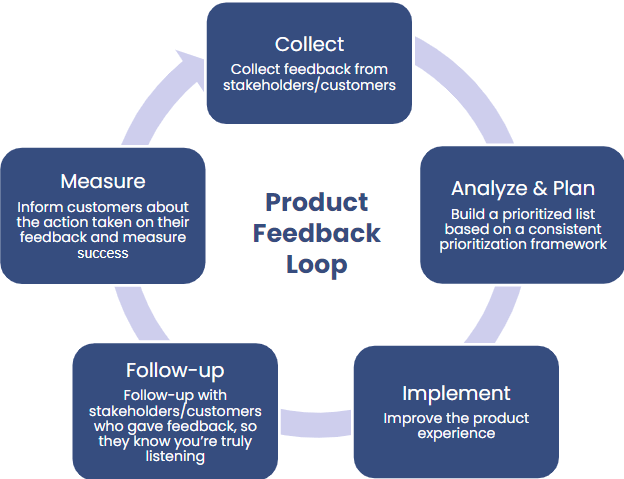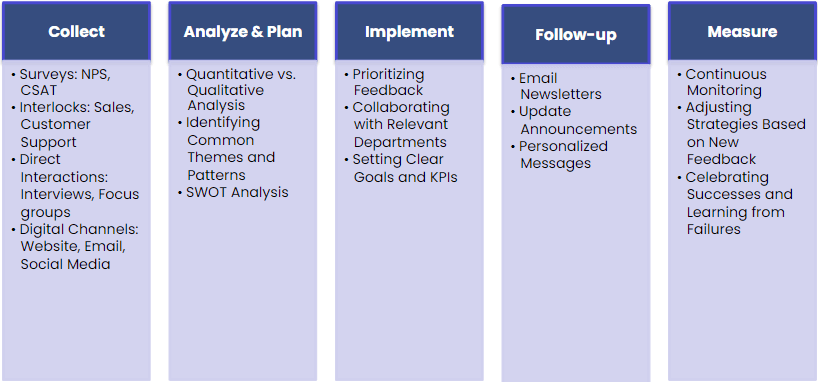The "Product Feedback Loop" is a vital process where user feedback is continuously collected, analyzed, and used to enhance the product. It bridges the gap between product teams and end-users, ensuring products align with market demands. The loop consists of five steps: collecting, organizing, implementing, following up, and communicating feedback. This systematic approach boosts customer experience, informs the product roadmap, builds loyalty, and identifies market trends. Proper execution and measurement of success are crucial for continuous product improvement.
This article covers.
Many organizations struggle to correctly capture and act on user feedback, leading to products misaligned with market demands. Furthermore, without a systematic approach to collecting, analyzing, and implementing feedback, businesses risk creating a disconnect between their product development teams and their end-users.
Few industry data points
Companies that implement a product feedback loop are 50% more likely to have successful products (Source: Gartner)
Companies with a product feedback loop have a 25% higher customer retention rate than companies without one. (Source: Forrester)
Companies that use product feedback loops to improve their products have a 10% higher customer satisfaction score than companies that don't. (Source: Gartner)
Companies that implement product feedback loops have a 20% higher revenue growth rate than companies that don't. (Source: McKinsey)
Solution: A continuous, efficient product feedback loop is crucial for user-centric product development
A "Product Feedback Loop" is a continuous cycle in which feedback about a product is collected from users, analyzed by the product team, and then used to make improvements to the product. Once these improvements are implemented, the team follows up with users to ensure the changes address their feedback effectively. This ensures to evolve product based on user needs and preferences while consistently validating its effectiveness
The primary goal is to deliver the highest level of customer experience by addressing the foremost trust issues and product gaps that hinder satisfaction. By closely analyzing these challenges, we are able to inform our product roadmap effectively, ensuring the development of features that promise the highest returns in terms of revenue and customer impact. This initiative not only helps in building customer loyalty and trust but also aids in identifying prevailing market trends and opportunities, providing a solid foundation for validating product decisions. Additionally, our efforts to reduce the churn rate are complemented by driving momentum and ensuring accountability through the implementation of Service Level Agreements (SLAs) and clear acceptance criteria, thus fostering a more reliable product ecosystem.
Now let's dive into the steps of building a product feedback loop process
Overall, by following the below simple 5 step processes, we make sure our product keeps getting better and that our users feel heard.

The process of enhancing our offerings begins with the collection of feedback, utilizing a variety of strategies. These include leveraging tools such as NPS (Net Promoter Score) and CSAT (Customer Satisfaction Score) surveys, consulting with our sales and support teams, engaging directly with users via interviews or focus groups, and not overlooking feedback gathered through our website, emails, and social media channels. Once feedback is collected, we delve into a thorough analysis, examining both quantitative data and qualitative insights. By identifying common themes and employing tools like SWOT analysis, we gain a comprehensive understanding of our strengths, weaknesses, opportunities, and threats. With this analysis, we strategically decide on our action items, collaborating with the relevant teams within our company and utilizing a consistent prioritization framework while setting clear targets to monitor our progress. Following the implementation of changes, we ensure to keep our users informed through various channels such as email newsletters, announcements, or personal messages, detailing what has been updated. Lastly, we continuously monitor the impact of these changes, ready to make adjustments based on new feedback and taking the time to acknowledge our successes and learn from any shortcomings. For example:

Let’s take an example: Mobile Application navigation feature - To enhance a mobile app's navigation feature, we initiated a feedback loop starting with NPS and CSAT surveys, alongside insights from sales, support teams, and social media. Analysis revealed appreciation for quicker access but confusion over the new interface's intuitiveness. Employing SWOT analysis, we identified this as a key area for improvement. Prioritizing usability enhancements, our product and design teams refined the interface, setting clear targets for improved user satisfaction and reduced support queries. Post-implementation, we informed users of changes through emails, app updates, and personal messages, demonstrating the value of their feedback. Continuously monitoring the impact, we remained ready to adjust further, with our commitment to user-centric development. This approach not only addressed user concerns but also reinforced our dedication to evolving our product based on direct user input.
By following these different strategies, we ensure that our product evolves based on real user feedback and that we're always improving
Here are some of the success metrics from both quantitative and qualitative standpoint that we can track to measure the effectiveness of the feedback loop process.
The concept of a "Product Feedback Loop" represents a dynamic, ongoing process where user feedback is systematically gathered, evaluated, and applied to enhance the product. This cycle ensures that product evolution aligns with user demands and preferences, continually validating its relevance and effectiveness. Such a strategy is pivotal in delivering exceptional customer experiences, bridging product gaps, shaping the product roadmap, and developing features that maximize revenue and impact on customers. Furthermore, it plays a critical role in fostering customer loyalty, spotting market trends, making informed product decisions, and minimizing the churn rate.
A core component of this approach is a structured execution process comprising five essential steps: the collection of feedback through various channels, the organization and prioritization of this feedback, the implementation of improvements based on the insights gained, the follow-up with contributors to acknowledge their input, and the broad communication of changes made to the wider customer base. This methodical approach not only ensures continuous product enhancement but also reinforces to users that their feedback is valued and has a tangible impact, thereby fostering a stronger connection between the product and its users.
Explore more great product management content by exploring our Content A-Z









Comments
Join the community
Sign up for free to share your thoughts